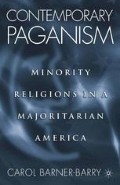Abstract
Throughout the world during most of recorded time, religion and ideas about the sacred have permeated social life. Ancient artifacts and myths indicate that our distant ancestors’ concept of the sacred affected public, as well as private, life. Human societies have, to a greater or lesser extent, been regulated with an eye to whether the actions of both individuals and social institutions are consistent with whatever is considered sacred by the dominant religion’s theology. Something as basic as the prevailing perception of the nature of the deity (or deities) can profoundly affect public policy making, as well as individual conduct (Berger, 1985; Gimbutas, 1982; Goodrich, 1990).
Access this chapter
Tax calculation will be finalised at checkout
Purchases are for personal use only
Preview
Unable to display preview. Download preview PDF.
Copyright information
© 2005 Carol Barner-Barry
About this chapter
Cite this chapter
Barner-Barry, C. (2005). The Emerging Pagan Movement in America. In: Contemporary Paganism: Minority Religions in a Majoritarian America. Palgrave Macmillan, New York. https://doi.org/10.1007/978-1-4039-7338-2_3
Download citation
DOI: https://doi.org/10.1007/978-1-4039-7338-2_3
Publisher Name: Palgrave Macmillan, New York
Print ISBN: 978-1-349-99969-9
Online ISBN: 978-1-4039-7338-2
eBook Packages: Palgrave Political & Intern. Studies CollectionPolitical Science and International Studies (R0)

